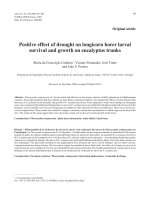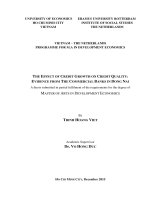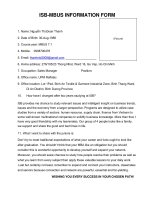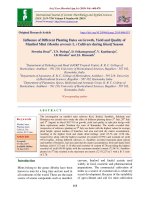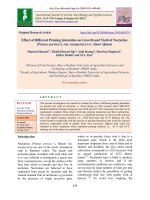Effect of different cultural media on growth of Sclerotium Rolfsii Sacc. causing root rot of chilli
Bạn đang xem bản rút gọn của tài liệu. Xem và tải ngay bản đầy đủ của tài liệu tại đây (319.87 KB, 6 trang )
Int.J.Curr.Microbiol.App.Sci (2019) 8(2): 3019-3024
International Journal of Current Microbiology and Applied Sciences
ISSN: 2319-7706 Volume 8 Number 02 (2019)
Journal homepage:
Original Research Article
/>
Effect of Different Cultural Media on Growth of Sclerotium rolfsii sacc.
causing Root Rot of Chilli
T.S. Archana*, Pankaj B. Deore, S.D. Jagtap and B.S. Patil
Department Plant Pathology, College of Agriculture, Dhule- 424 004
Mahatma Phule Krishi Vidyapeeth, Rahuri (Maharashtra, India)
*Corresponding author
ABSTRACT
Keywords
Sclerotium rolfsii,
Host extract agar
medium, Potato
dextrose agar
Article Info
Accepted:
22 January 2019
Available Online:
10 February 2019
Chilli is grown in many states in India as a valuable trade crop. Chilli accounts for
20-30% of total Indian spices exports valuing approx Rs. 400-500 cores. Nine
cultural media Potato dextrose agar, Host extract agar (Chilli), Oat meal agar,
Carrot agar, Plane agar, Richards agar, Czapeks agar, Elliots agar, Saboroud’s
agar were analyzed for in vitro mycelial growth of Sclerotium rolfsii. The cultural
characteristics indicated that the excellent growth and sclerotia formation were
observed on different semi-synthetic media viz., Potato dextrose agar and Host
extract agar medium (Chilli) followed by Oat meal agar, Saboround’s agar and
Richard’s agar.
Introduction
Sclerotium rolfsii is widely distributed in
tropics, subtropics and also in warmer parts of
temperate zone of the world. In India, it is
wide spread in almost all the states and
causing economic losses in many crops. The
numerous reports from tropical and
subtropical areas of the world, coupled with
the large number of hosts attacked by it
indicate that, economic losses are substantial
every year due to infection of Sclerotium
rolfsii (Aycock, 1966). Sclerotium rolfsii is a
soil inhabitant, non-target, polyphagous and
an ubiquitous facultative parasite. It has wide
host range infecting particularly solanaceous
crops. It is documented that, fungus infects
more than 500 plant species (Rupe, 1999).
Among the soil borne diseases, root rot
caused by Sclerotium rolfsii is gaining a
serious status. This disease also referred as
Sclerotium blight, Sclerotium wilt, Southern
blight, Southern stem rot and white mold.
This fungus is distributed throughout the
world and is particularly prevalent in warmer
climate and significant yield losses can be
seen in monoculture or short rotation with
other crops which are susceptible to this
pathogen (Aken and Dashiell, 1991).
3019
Int.J.Curr.Microbiol.App.Sci (2019) 8(2): 3019-3024
Materials and Methods
Synthetic media
Isolation of Sclerotium rolfsii
Richard’s agar
Isolation of Sclerotium rolfsii was carried out
from diseases chilli plant collected from
Khandesh redion.
Potassium nitrate (KNO3) = 10 g Potassium
monobasic phosphate (KH2PO4)= 5 g
Magnesium sulphate (Mg SO4.7H2O) = 2.5 g,
Ferric chloride (Fecl3.6H2O) = 0.02 g
Sucrose (C12H22O11) = 50 g
Agar-agar = 15 g
Distilled water = 1000 ml.
Cultural studies
The cultural characters of the pathogen were
studied on the following solid media viz.,
1. Potato dextrose agar
Potato = 200 g
Dextrose =20 g
Agar = 20 g
Distilled water =1000 ml
2. Host extract agar (chilli)
Healthy chilli leaves = 200 g
Dextrose = 20 g
Agar-agar = 20 g
Distilled water =1000 ml
3. Oat meal agar
Oat meal = 30 g
Agar-agar = 20 g
Distilled water =1000 ml
4. Carrot agar
Carrot = 200 g
Dextrose = 20 g
Agar-agar = 20 g
Distilled water = 1000 ml
5. Plane agar
Dextose = 20 g
Agar-agar = 20 g
Distilled water = 1000 ml
Czapek’s Dox agar
Sodium nitrate (NaNO3) = 3 g
Potassium dihydrogen phosphate (K2HPO4)
=1 g
Magnesium sulphate (MgSO4. 7H2O) = 0.5 g
Ferrous sulphate (FeSO4.7H2O)=0.19 g,
Sucrose (C12H22O11) =30 g
Agar-agar = 15 g
Distilled water = 1000 ml
Elliot’s Agar (EA)
Sodium carbonate (Na2CO3) =1.05g
Magnesium sulphate (MgSO4.7H2O) = 0.60 g
Asparagine = 3.00 g
Dextrose (C6H12O6) =3.00g
Potassium dihydrogen orthophosphate = 1.36
g (KH2PO4)
Agar-agar = 20.00 g
Distilled water = 1000 ml
Sabouround’s agar
Dextrose = 200 g
Peptone = 20 g
Agar-agar = 20 g
Distilled water = 1000 ml
Results and Discussion
The results obtained from the present
investigation are summarized below:
3020
Int.J.Curr.Microbiol.App.Sci (2019) 8(2): 3019-3024
Table.1 Effect of different cultural media on colony diameter, growth characters and Sclerotia formation of S. rolfsii Sacc. causing
root rot of chilli
Average colony Growth characters
diameter (cm)*
10 days after
Inoculation
Tr.
No.
Media
1
Potato
dextrose
Growth
9.0
Mycelium milky white, flat thick mycellial growth with good sclerotia formation
++++
9.0
Mycelium milky white, flat thick growth and dark sclerotia were formed
++++
3
Host extract
agar(Chilli)
Oat meal agar
8.0
Mycelium is milky white, fluffy and sclerotia formed
+++
4
Carrot agar
7.1
White thick mycelium. sclerotia were formed.
+++
5
Plane agar
4.2
White pale and thin mycelium.no sclerotia formation
6
Richards agar
7.5
Milky white mycelim with uniform margin .dark,small sclerotia were formed.
+++
7
Czapeks agar
6.1
White mycelium with flat round growth. sclerotia were formed
++
8
Elliots agar
2.2
White mycelium with uneven topography. Sclerotia were lately formed
+
9
Saboround’s agar
8.2
White thick fluffy mycelium. Sclerotia formed
S.E. ±
0.09
C.D. at 5%
0.26
agar
2
+ Very poor ++ Poor +++ Moderate ++++ Good, * Mean of three replication
3021
-
+++
Int.J.Curr.Microbiol.App.Sci (2019) 8(2): 3019-3024
Plate.1 Effect of different cultural media on growth of Sclerotium rolfsii
T1 Potato dextrose agar
T2 Host extract agar
T3 Oat meal agar
T4 Carrot agar
T5 Plane agar
T6 Richard's agar
T7 Czapek's agar
T8 Elliot's agar
T9 Saboround's agar
Effect of different cultural media on
growth of S. rolfsii. Sacc
Cultural characters of the test fungus were
studied on nine different synthetic and semisynthetic media. After seven days of
inoculation, the treatment differences in
respect of colony diameter, growth
characteristics and sclerotia formation were
noticed, which are presented in Table 1 and
Plate-1.
3022
Int.J.Curr.Microbiol.App.Sci (2019) 8(2): 3019-3024
Growth
The result presented in Table 1 revealed that
the maximum growth was recorded on Potato
dextrose and host extract agar medium with
milky white, flat thick mycellial growth with
colony diameter of 9.0 cm followed by
Saboroud’s agar medium with colony
diameter 8.2 cm which produced white thick
fluffy mycelium.
The next best treatments were Oat meal 8.0
cm with milky white fluffy colony, Richard’s
agar media has of 7.5 cm with aerial milky
white mycelium with uniform margin
followed by, Carrot agar with 7.1 cm with
white thick mycelium, Czapek’s Dox agar 6.1
cm with circular flat white mycelium, Plane
agar medium 4.2 cm colony diameter with
pale thin growth of mycelium and Elliot’s
agar 2.2 cm produced white mycelium with
uneven topography.
In conclusion, cultural characters of fungus
were studied on nine solid media. The
excellent growth and sclerotia formation was
observed on Potato dextrose agar and Host
extract agar medium (Chilli) followed by
Saboroud’s agar, Oat meal and Richards’
agar. The colony of Sclerotium rolfsii was
circular, white with thick growth on the upper
surface of PDA.
References
Abeygunawardana, D.V.W. and R.K.S.
Wood.
1957.
Factors
affecting
germination and mycelia growth of
Sclerotium rolfsii Sacc. Trans. Brit.
Mycol. Soc., 40: 221-231.
Aycock, R. 1966. Stem rot and other diseases
caused by Sclerotium rolfsii. N.C.
Agric. Exp. Stn. Tech. Bull. 174: 202.
Basamma, Keshav Naik., C. Madhura and
L.M Anjunath 2012. Cultural and
physiological studies on Sclerotium
rolfsii causing sclerotium wilt of potato.
International Journal of Plant Science.
7 (2) 216-219.
Rupe, J. C. 1999. Sclerotium blights. In:
Compendium of Soybean Diseases.4th
ed. Hartman G. L., Sinclair J. B. and
Rupe J. C., APS Press, The American
Phytopathological Society.100.
Aken, C. N. and Dashiell, K. E. 1991. First
report of southern blight caused by
Sclerotium rolfsii on soybean in
Nigeria. Plant Dis. 75: 537.
Endo, S. 1935. Influence of H+ ion
concentration on the mycelial growth of
causal fungi of sclerotial disease of rice.
Plant Bull. Miyazaki. 8(1):11.
Gawande, M., Bagyaraj, J., Sirsi. 2013.
Studies on oxalic acid synthesis by
Sclerotium rolfsii Sacc. Current
Sciences. 34(7): 458-459.
Grover, R.K. and B.L. Chona. 1960.
Comparative studies on Sclerotium
rolfsii Sacc. and Ozonium taxanus Neal.
and Wester var. parasiticum. Indian
phytopath. 13(4): 118-129.
Hussain Azhar, Iqbal Muhammad, Majid
Abdul. 2003. Physiological study of
Sclerotium rolfsii Sacc. Pakistan
Journal of plant pathology. 2(2):102106.
Indramani Bhagat. 2011. Factors influencing
mycelia growth of Sclerotium rolfsii.
Sacc. Journal of Biosciences. 1: 26-31.
Misra, A.P. and Haque, S. Q. 1962. Factors
affecting the growth and sclerotial
production in Sclerotium rolfsii causing
storage rot of potato. proc. Ind. Acad.
Sci. Sect. B. 56(3):157-168.
Muthukumar
and
Venkadesh.
2013.
Physiological studies on Sclerotim
rolfsii Sacc. causing collar rot of
peppermint.
African
Journal
of
Biotechnology. 12(49): 6837-6842.
Patil, B.G. 1963. Studies on isolation,
Pathogenicity and Physiology of
Sclerotium rolfsii Sacc. Causing wilt of
3023
Int.J.Curr.Microbiol.App.Sci (2019) 8(2): 3019-3024
groundnut. Thesis M.Sc. (Agri.)
submitted to university of Nagpur.
Reddi Kumar, Madhavi santhoshi, T.
Giridhara Krishna and K. Raja Reddy.
2014. Cultural and Morphological
Variability Sclerotium rolfsii isolates
infecting Groundnut and its relation to
some fungicides. International Journal
of current Microbiology and Applied
Sciences. 3(10): 553-561.
Ronak Kumar and Sumanbhai, M. 2015.
Cultural and physiological studies on
Sclerotium rolfsii causing scleotium wilt
of potato. International Journal of Plant
Sciences. 7(2): 216-218.
Shridha Chaurasia, Kumar Amit., Shubha
Chaurasia and Sushmita Chaurasia.
2014.
Pathological
Studies
of
Sclerotium rolfsii causing Foot rot
disease of Brinjal (Solanum melongena
Linn.).
International
journal
of
pharmacy and life sciences. 5(1): 32573264.
Sumia Fatima and Uzma Quadri. 2015. The
effect of different media on radial
growth of Sclerotium rolfsii causing
chilli root rot. Trends in life sciences.
4(4): 778-780.
Takahashi, T. 1927. A Sclerotium disease of
Larkspur. Phytopathology, 17(3):239244.
Zamir K. Punja. 1895. The Biology, Ecology
and Control of Sclerotium rolfsii Sacc.
Ann. Rev Phytopathology. 23(2):97127.
How to cite this article:
Archana, T.S., Pankaj B. Deore, S.D. Jagtap and Patil, B.S. 2019. Effect of Different Cultural
Media on Growth of Sclerotium rolfsii sacc. causing Root Rot of Chilli.
Int.J.Curr.Microbiol.App.Sci. 8(02): 3019-3024. doi: />
3024
